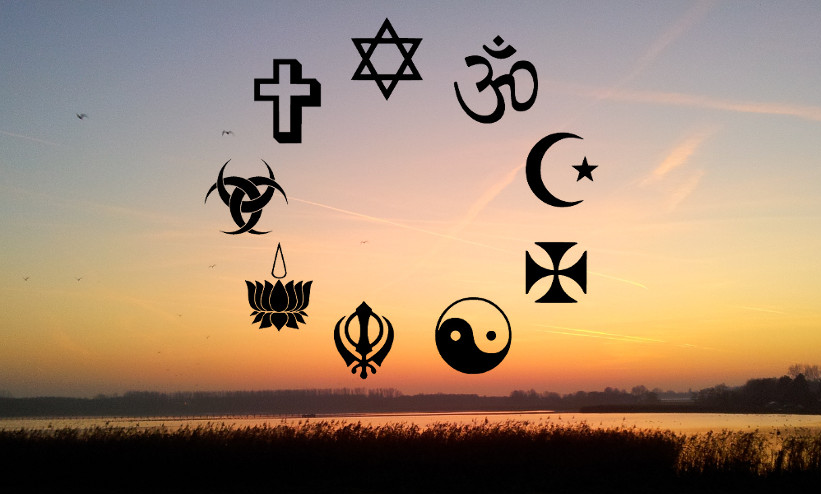 Richard’s pilgrimage next led him southeast to Prayaga, praised as the king of holy places. This was home of the Kumbha Mela, the largest gathering on earth where up to twenty million pilgrims gather every twelve years to meet saintly people and take a religious purification bath. Prayaga is situated at the confluence of three rivers: the Ganges, Yamuna, and Saraswati. Richard walked barefoot in the unbearably hot sand, and arrived at the confluence where he saw the river Yamuna embracing Mother Ganges—Yamuna with her complexion of deep blue, Ganges with hers of white, and the transparent Saraswati joined them from below.
Richard’s pilgrimage next led him southeast to Prayaga, praised as the king of holy places. This was home of the Kumbha Mela, the largest gathering on earth where up to twenty million pilgrims gather every twelve years to meet saintly people and take a religious purification bath. Prayaga is situated at the confluence of three rivers: the Ganges, Yamuna, and Saraswati. Richard walked barefoot in the unbearably hot sand, and arrived at the confluence where he saw the river Yamuna embracing Mother Ganges—Yamuna with her complexion of deep blue, Ganges with hers of white, and the transparent Saraswati joined them from below.
Sitting on the sandy bank, Richard gazed into the sky and saw a hawk plunge headlong into the Ganges. There, a frantic underwater skirmish ensued until he emerged with a flapping fish, about a foot long, pierced in the grip of his talons. Squirming desperately, the fish was carried overhead and into a nearby forest. Looking on Richard reflected:
“The unsuspecting fish, who knew nothing but a life in the river, went about its routine like any other day, but in an instant was ripped out of its reality to meet with death. Like that fish, we routinely live our lives hardly aware that, at the least expected moment, the yellow-eyed hawk of fate in the form of crises, tragedy, or even death, may wrench us out of our comfortable environment. We regularly hear of it in the news or see it around us but rarely take seriously that it could happen to us. Perhaps the lesson here is to guard against complacency and give higher priority to our spiritual needs. If the fish swam deeper, the hawk would not be able reach it. Similarly, if we go deeper into our connection to God, we will find an inner reality so deep and so satisfying that it lifts the consciousness to a place where we could deal with the effects of unforeseeable fate with a stable, detached mind.”
Radhanath Swami appeals that in this material world there is danger at every step and death could come at any time. Therefore a spiritualist spends every moment remembering God so that during the eventual moment of death, he is fixed in an inner state of bliss, ready to enter the divine realm of God. Radhanath Swami says, “A spiritualist doesn’t let a breath pass without remembering God.” Although this may appear presently impractical, our goal is to attain that state of constant remembrance. Radhanath Swami’s oft quoted phrase is, “To forget God is worse than death.”
Radhanath Swami believes that for a spiritual seeker death is not the end, rather it’s a beginning of entrance into a realm of eternity, knowledge and bliss. For a materialist, death is simply the end of everything he or she identifies with. Therefore a God lover doesn’t mind getting old or nearing death, because he knows that as the body is coming closer to death, the soul is getting closer to the eternal spiritual youthful form. Therefore Radhanath Swami’s catchy reminder for us is ‘die before you die’
Radhanath Swami has observed in his four decade of spiritual practices that as inevitable death approaches, all sincere devotees of God are not fearful of losing anything of this world. I once heard Radhanath Swami’s student give a striking example, “In a typical Hindu marriage, the bride cries as she leaves her parents’ house. This is because of her familial attachments and the uncertain future waiting to unfold at her husband’s home. But if a long courtship precedes her wedding, she silently celebrates the parting from her loved ones. Similarly a devotee constantly associating with God through service and remembrance fills his life with serenity and bliss and easily turns from worldly attachments. Then when the inevitable death approaches, he is excited to be reunited with his beloved Lord”
Source: http://www.radhanath-swami.net/facing-inevitable-death/facing-inevitable-death



